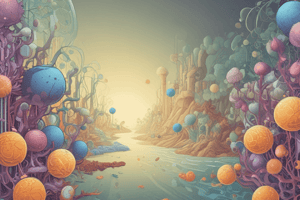Podcast
Questions and Answers
What is a characteristic of microorganisms?
What is a characteristic of microorganisms?
- They are visible to the naked eye
- They are too small to be seen with the naked eye (correct)
- They are only found in the human body
- They are typically measured in meters or kilometers
What type of microorganism is characterized by having a nucleus and membrane-bound organelles?
What type of microorganism is characterized by having a nucleus and membrane-bound organelles?
- Viruses
- Fungi (correct)
- Bacteria
- Protists
What is an example of a protist?
What is an example of a protist?
- Influenza
- Amoeba (correct)
- Yeast
- E. coli
What is the diameter range of bacteria?
What is the diameter range of bacteria?
What is the process of breaking down organic matter into simpler compounds?
What is the process of breaking down organic matter into simpler compounds?
What is an example of mutualism?
What is an example of mutualism?
What is the term for living together in a close, often beneficial relationship?
What is the term for living together in a close, often beneficial relationship?
What is the term for causing disease in humans, animals, and plants?
What is the term for causing disease in humans, animals, and plants?
Flashcards are hidden until you start studying
Study Notes
Definition and Characteristics
- Microorganisms are tiny living organisms that are too small to be seen with the naked eye
- They are typically measured in micrometers (μm) or nanometers (nm)
- Microorganisms can be found almost everywhere on Earth, including in soil, water, air, and the human body
Types of Microorganisms
- Bacteria: prokaryotic cells, no nucleus or membrane-bound organelles
- Examples: E. coli, Staphylococcus aureus, Bacillus subtilis
- Viruses: not considered living cells, consist of genetic material surrounded by a protein coat
- Examples: Influenza, HIV, Ebola
- Fungi: eukaryotic cells, have a nucleus and membrane-bound organelles
- Examples: Yeast, Mold, Mushrooms
- Protists: eukaryotic cells, do not fit into any other category
- Examples: Amoeba, Paramecium, Giardia
Microorganism Sizes
- Bacteria: 0.5-5.0 μm in diameter
- Viruses: 20-400 nm in diameter
- Fungi: 2-10 μm in diameter
- Protists: 1-100 μm in diameter
Microorganism Functions
- Decomposition: breaking down organic matter into simpler compounds
- Fixation: converting nitrogen gas into a usable form
- Fermentation: converting glucose into energy
- Pathogenesis: causing disease in humans, animals, and plants
Microorganism Interactions
- Symbiosis: living together in a close, often beneficial relationship
- Examples: gut microbiome, coral-algae symbiosis
- Antagonism: competing with each other for resources
- Examples: antibiotic production, competition for nutrients
- Mutualism: both organisms benefit from the interaction
- Examples: mycorrhizal fungi, lichen formation
Microorganisms: Definition and Characteristics
- Microorganisms are tiny living organisms that are too small to be seen with the naked eye, typically measured in micrometers (μm) or nanometers (nm).
- They can be found almost everywhere on Earth, including in soil, water, air, and the human body.
Types of Microorganisms
- Bacteria: prokaryotic cells with no nucleus or membrane-bound organelles, examples include E. coli, Staphylococcus aureus, and Bacillus subtilis.
- Viruses: not considered living cells, consist of genetic material surrounded by a protein coat, examples include Influenza, HIV, and Ebola.
- Fungi: eukaryotic cells with a nucleus and membrane-bound organelles, examples include Yeast, Mold, and Mushrooms.
- Protists: eukaryotic cells that don't fit into any other category, examples include Amoeba, Paramecium, and Giardia.
Microorganism Sizes
- Bacteria: 0.5-5.0 μm in diameter.
- Viruses: 20-400 nm in diameter.
- Fungi: 2-10 μm in diameter.
- Protists: 1-100 μm in diameter.
Microorganism Functions
- Decomposition: breaking down organic matter into simpler compounds.
- Fixation: converting nitrogen gas into a usable form.
- Fermentation: converting glucose into energy.
- Pathogenesis: causing disease in humans, animals, and plants.
Microorganism Interactions
- Symbiosis: living together in a close, often beneficial relationship, examples include gut microbiome and coral-algae symbiosis.
- Antagonism: competing with each other for resources, examples include antibiotic production and competition for nutrients.
- Mutualism: both organisms benefit from the interaction, examples include mycorrhizal fungi and lichen formation.
Studying That Suits You
Use AI to generate personalized quizzes and flashcards to suit your learning preferences.




